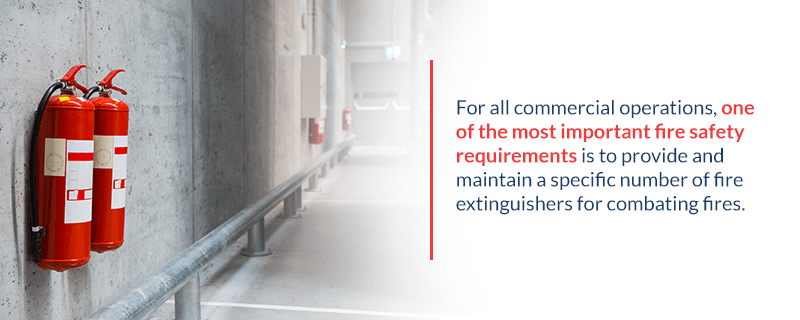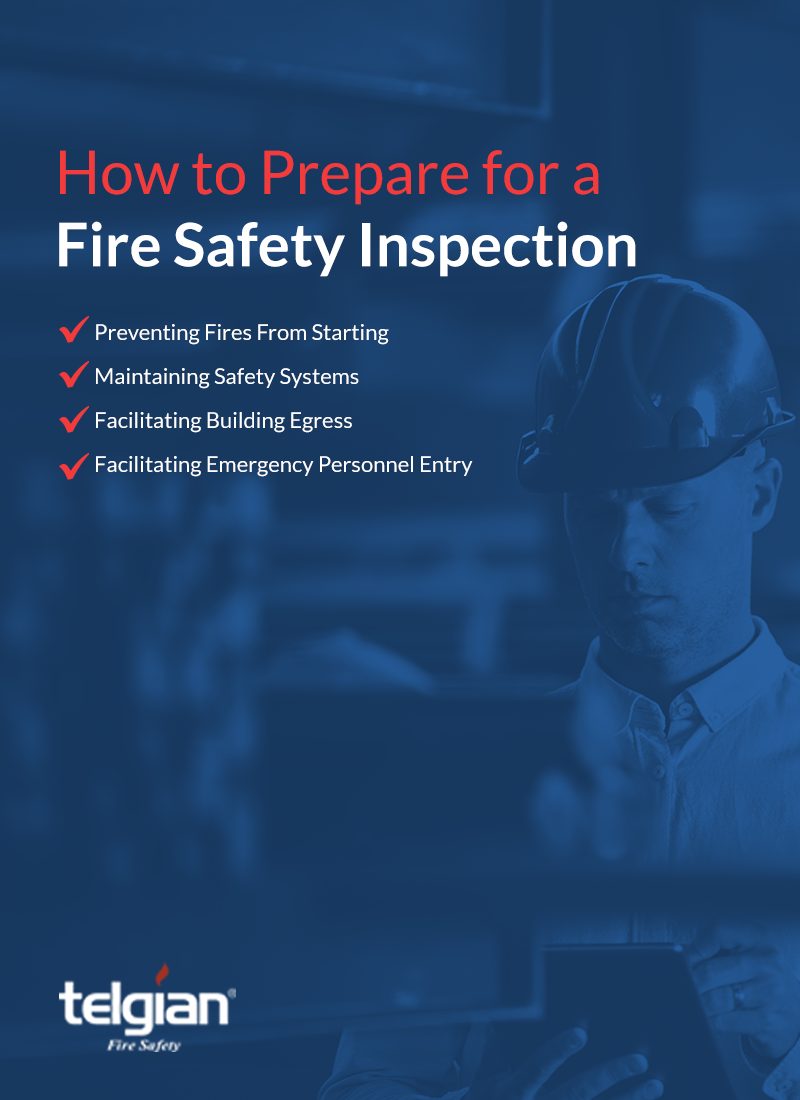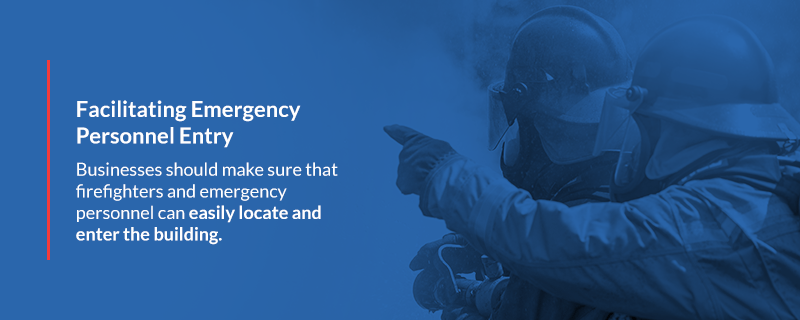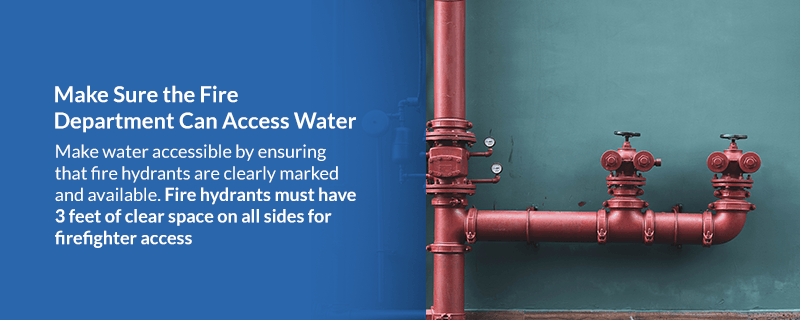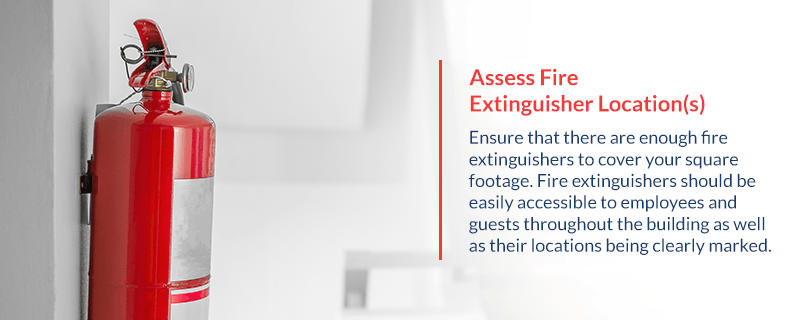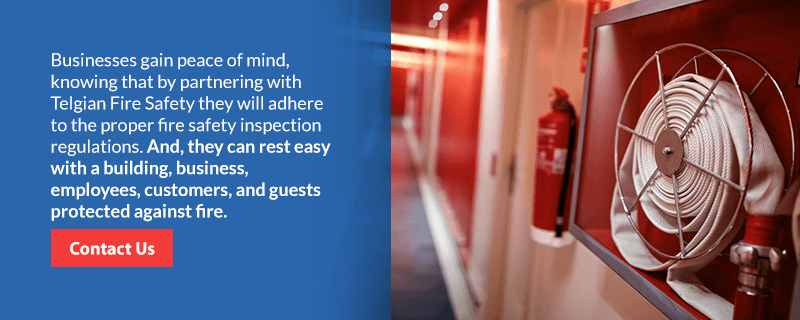In the United States, a structure fire starts every 63 seconds, and, the consequences can be devastating for homes and businesses alike. According to U.S. Fire Administration, there were over 110,000 non-residential fires in 2019, resulting in about 100 deaths, over 1,000 injuries and almost $3 billion in damages.
Keeping safety equipment in good working order is also imperative. Data shows active sprinkler systems are effective in fighting fires 88% of the time when they are activated. NFPA also reports that death rates in office property fires where sprinkler systems are present are 62% lower than in those without sprinklers.
However, keeping a building up to code, however, can be complicated. For example, 42 states and the District of Columbia follow the International Fire Code. The remaining states use NFPA’s Fire Prevention Code, NFPA 1, sometimes in conjunction with the IFC. Both of these documents refer to the family of NFPA codes and standards. States that have not adopted the IFC include Florida, Hawaii, Maine, Maryland, Massachusetts, Rhode Island, Vermont and West Virginia. So, companies in these states will need to check their local ordinances to find out how to comply with fire safety regulations. It is always a good idea to know the local adjustments or amendments to the national codes.
Staying up to code includes regular fire safety inspections, which help prevent devastating losses from fire. Fire safety inspectors ensure equipment, such as sprinkler systems, smoke alarms, fire doors and fire alarms, performs as it should. Inspectors can also check that electrical systems and cooking equipment meet safety standards.
Below, we will walk you through the steps to take to make sure your company knows how to pass a potentially lifesaving fire safety inspection.
Fire Safety Inspection Requirements
Fire inspectors have an essential checklist to complete when performing fire safety inspections. Since these requirements vary by state, business owners and managers must become familiar with individual state fire codes, ordinances and standards, as well as how to comply. These fire codes exist to tell businesses what requirements they must meet, what types of equipment they must install based on a structure’s size and usage and how they should install required equipment.
Some types of businesses require more frequent fire safety inspections than others. Most companies receive a visit from the fire marshal once a year. Places of public assembly, such as theaters, nightclubs, hotels and even hospitals, need more frequent inspections. And, buildings such as high-rises must adhere to highly stringent fire code requirements due to high occupancy and complicated egress for those on higher floors. Fire inspections may seem like a periodic nuisance for a building’s owner or manager. However, fire safety requirements offer valuable benefits to employees, managers and owners alike.
- Workplace safety: Working in a building that passes a fire code inspection gives employees peace of mind about their security at work.
- Building security: Modern construction codes can limit total losses from fire. Keeping a workplace up to code can make the difference between saving and losing an entire building.
- Security from business interruption: When a fire occurs, it will likely suspend business operations for days or weeks, if not permanently. Staying up to code allows businesses to minimize damage and return to normal operations quickly after a fire.
- Customer base retention: If a business closes down for weeks due to fire damage, even loyal customers will need to look elsewhere. Adhering to fire codes provides businesses with a better chance of maintaining clientele.
- More favorable insurance rates: Many insurance companies incentivize the installation of safety features such as smoke detectors and sprinkler systems. Businesses can realize significant rate reductions by taking this extra step.
Fire inspection requirements affect many areas of a building’s systems and functionality. Prepare your facility to make the necessary changes to accommodate the professionals during the inspection and follow their standards afterward. Some of these include the following.
- Unlocked doors: An inspection may reveal what doors should remain unlocked during the workday to ensure safety standards.
- Safety systems: A fire inspector can tell you what safety systems you need to install to bring your building up to code.
- Professional maintenance: After the inspection, a professional can tell you when to schedule consistent maintenance on your systems.
- Stored materials: If your company stores products or materials within the building, a fire inspection will tell you how to best store items to reduce risks.
- Electrical systems: Many electrical systems require specific labels to ensure they follow standards and codes.
Fire Extinguisher Requirements
For all commercial operations, one of the most critical fire safety requirements is to provide and maintain a specific number of fire extinguishers for combating fires. The number and location of fire extinguishers required in a building depend on the type used. The actual requirements are in NFPA 10 and the IFC. Most fire extinguishers fall under types A, B, C or K. These letter classifications refer to the kind of materials they can extinguish.
- Class A: These fire extinguishers put out trash, wood, and paper fires.
- Class B: These fire extinguishers are for flammable liquid fires, such as oil and gasoline fires.
- Class C: These fire extinguishers are safe to use on energized electrical equipment.
- Class K: These fire extinguishers are used for kitchen fires, such as fires that start from burning grease, fats and oils.
Each fire extinguisher includes an alphanumerical rating, such as 1-A. An extinguisher rated 1-A can put out a fire of a particular size. A fire extinguisher rated 2-A can put out a fire about twice as large.
1. Class A Fire Extinguishers
Businesses using class A fire extinguishers should place them no less than 75 feet apart throughout the building. Additionally, in areas of low hazard occupancy, each fire extinguisher should cover an area of no more than 3,000 square feet per the extinguisher’s A rating. Therefore, an extinguisher rated 2-A, which is the minimum rating required under the IFC, can cover 6,000 square feet. An extinguisher rated 3-A can cover 9,000 square feet.
In areas of moderate hazard occupancy, each fire extinguisher should cover an area of no more than 1,500 square feet per A rating. In high-hazard occupancy, each fire extinguisher should cover an area of no more than 1,000 square feet per its A rating. No matter its numerical rating, no single type A fire extinguisher should ever cover more than 11,250 square feet.
2. Class B and C Fire Extinguishers
For areas using class B and C fire extinguishers, the distance that any person in the building must travel to reach a fire extinguisher is less than 30 or 50 feet, depending on the rating of the fire extinguishers.
In areas of low hazard, the minimum extinguisher rating is 5-B or 5-C. The travel distances to these extinguishers must be less than 30 feet. If fire extinguishers in these areas are rated 10-B or 10-C or above, the maximum travel distance must be less than 50 feet.
For areas of moderate hazard, the minimum extinguisher rating is 10-B or 10-C. The travel distances to these extinguishers must be less than 30 feet. If fire extinguishers in these areas are 20-B, 20-C or above, the maximum travel distance must be less than 50 feet.
The minimum extinguisher rating in areas of high hazard is 40-B or 40-C. The travel distances to these extinguishers must be less than 30 feet. If fire extinguishers in these areas are 80-B, 80-C or higher, the maximum travel distance must be less than 50 feet.
Most facilities use extinguishers rated for classes A, B and C to meet the requirements set by fire safety inspection professionals.
3. Class K Fire Extinguishers
Class K fire extinguishers, used for kitchen fires, must be within 30 feet of cooking stations. One 1.5-gallon fire extinguisher of this type can cover a maximum of four moderate-sized fryers. The use of more fryers and cooking stations requires additional extinguishers. If a fixed hood system is in place, use it first, then switch to a portable unit as needed.
Preparing for a Fire Safety Inspection: What You Need to Know
Preparing for a fire safety inspection is critical, especially for businesses subject to unscheduled inspections. With unscheduled inspections, fire inspectors may hope to see what the building’s working and safety conditions are like during a typical day, and not just on the day when managers have specifically prepared for inspection. Being prepared at all times greatly enhances the likelihood of passing a drop-in inspection.
Fire safety inspectors evaluate several areas:
-
- Possible fires: Inspectors help determine the various ways fires could start within the facility.
- Safety systems: Professionals will check the safety systems, including the smoke alarms, sprinkler systems and fire extinguishers, to ensure they are in good condition. An inspector may request additional documentation about the maintenance performed on the system to see if the materials are up to date.
- Exit systems: For systems that assist with egress, an inspector will check lighted exit signs and doors to ensure they function correctly without impeding employees from exiting the building.
- Emergency access routes: During emergencies, firefighters or emergency responders should have immediate access to the building.
Businesses should take these steps to prepare for a fire safety inspection by checking on their compliance within each of these areas.
1. Preventing Fires From Starting
Companies can protect against fire ignition by ensuring electrical systems are in good working order and adequately insulated. A building’s electrical systems need inspecting at least once a year, if not more often, as specific local ordinances require.
2. Maintaining Safety Systems
Businesses should Continuously operate and maintain safety systems to assist with detecting, containing, and putting out fires. These systems can include smoke alarms to detect signs of fire, fire doors that swing closed automatically when the fire alarm system activates, and sprinkler systems that put out fires by dousing them from above. All of these safety systems should receive regular, professional inspections and have their batteries and other components replaced as needed.
3. Facilitating Building Egress
The best safety systems in the world are not enough if no one can get out of the building. To ensure that employees and guests escape safely from a fire, businesses should install and maintain directional exit lighting and illuminated exit signs. These features allow people to quickly locate the nearest means of egress.
Stairwells and exit hallways should always be free from obstruction, and doors should remain unlocked wherever possible. When doors must stay locked, it should be easy for a single person to open without specialized knowledge, strength or keys.
4. Facilitating Emergency Personnel Entry
Businesses should also make sure that firefighters and emergency personnel can easily locate and enter the building. They can do so by displaying the building address prominently (as required by the IFC), clearing fire lanes, and ensuring access to fire hydrants and building keys.
If the fire department has a “lockbox” program, ensure this box accurately reflects any changes you make to the facility keys. This update could require calling the fire department, and most firefighters or staff will be glad to stop by if you are proactive in maintaining access for them.
Despite your efforts to maintain an open environment for preparing fire safety inspections, an inspector might still find a violation. In that case, business owners and managers should prepare to talk to the inspector about the timeline for making corrections. It is also essential to understand who is responsible for making the building compliant with safety standards. Whether the business owner, the property manager or the building owner take on this responsibility, some of these delegations may be in the lease agreement or other paperwork.
Preparing for a Fire Safety Inspection: Your Fire Inspection Checklist
Your fire safety inspection checklist should include the following important items.
- Inspection reports: Collect and organize copies of previous inspection reports.
- System service inspections: Gather papers and documents that prove you have had your safety systems serviced and inspected consistently.
- System maintenance appointments: After inspection, make the necessary appointments for any outstanding safety systems that require maintenance.
- Heat system maintenance appointments: Schedule maintenance for any heat systems that still require it.
- Hazard protection: Protect your building from specific hazards like gasoline pumps or server rooms.
- Clear halls and stairs: Ensure the hallways and stairwells are clear of products or materials that could hinder employees from exiting the building.
- Store hazardous items: Store flammable and combustible items and products in their proper containers and away from fire hazards.
- Store incompatible materials: If any chemicals or materials are incompatible with each other, keep them separate from each other in safe containers.
- Ensure easy entry: Fire department personnel should have quick access to the building in case of emergencies.
- Give the fire department water access: The fire department should have easy access to water and fire hydrants near the building.
- Maintain electrical systems: Label and maintain electrical systems throughout the year.
- Check extension cords and power strips: Use extension cords and power strips appropriately to prevent electrical fires or shorts.
- Check exit signs: Exit signs and directional lights should be bright and unmistakable.
- Assess fire extinguishers: Make sure fire extinguishers are located in their correct positions and have not expired.
- Assess sprinklers: Make sure sprinkler heads are clear and clean without items hanging from them or nearby debris.
- Post safety signage: Post safety signs around the building to ensure employees are aware of safety features.
By reviewing and completing these items before your fire inspection, you’ll have a greater chance of passing and remaining in compliance with fire safety regulations.
1. Collect Copies of Previous Inspection Reports
Being proactive makes a good impression and lets the inspector know the company has invested in meeting requirements. Provide documentation of steps the company took to address any previous violations.
2. Collect Proof of System Service and Inspections
Collect the necessary paperwork to prove that licensed professionals have serviced fire alarms, fire extinguishers, sprinkler systems and fire pumps within the required time frame. How often do you need a fire inspection? Depending on the type of system, fire alarms typically need service annually, semiannually or quarterly.
Collect the necessary paperwork to show that applicable cooking hoods have received attention from a licensed professional within the required time frame, usually the past six months for standard cooking operations. Additionally, ccollect documentation proving an experienced technician has serviced any generators within the required time frame, usually the past year.
3. Make Appointments for Any Outstanding Safety Systems Maintenance
Maintain safety systems with the help of reputable, licensed contractors. Inspection, testing, and maintenance (ITM) of these systems can be complex and requires trained professionals with significant expertise in the field.
The company that provides inspection services should be able to complete or coordinate installation and repair services to make sure everything is working correctly. This company should also provide detailed documentation of any problems and their solutions. Many companies can perform several aspects of ITM at once, including checking emergency lighting, exit signs, fire extinguishers, sprinkler systems and fire alarms.
4. Make Appointments for Any Outstanding Heat Systems Maintenance
Maintain all heat-generating appliances, including boilers, furnaces, radiators, stoves, ovens and heat-producing manufacturing equipment. In the kitchen, cooking appliances should have hoods and hood suppression systems for automatic suppression of kitchen fires. These systems must also receive regular maintenance.
5. Protect Special Hazards
In a business, special hazards can include gasoline pumps, computer server rooms, chemical storage areas, and any other place with a high concentration of flammable or combustible materials. Make sure these hazards gain protection with properly maintained and inspected systems.
6. Clear Hallways and Stairwells
Maintain access to exits throughout the building. Many businesses that fail their fire inspections do so because they have provided insufficient means of egress. For example, businesses may store items in the hallways that lead to exit doors. If a fire occurred, these items would dramatically limit the flow of traffic out of the building.
Stairways and corridors should also include features such as fire doors and latch release mechanisms. All exit doors should be unobstructed and should open without difficulty for a single person without specialized keys or knowledge.
7. Store Flammable and Combustible Materials Properly
Typically, business must store combustible materials a specific distance from the ceiling in approved containers in good condition. Store flammable and combustible materials in amounts that do not exceed the maximums set by each state. Do not store them in rooms that produce heat, such as boiler rooms and electrical rooms. Additionally, do not keep them near appliances such as coffeemakers, microwaves, stoves or ovens, portable heaters or other heat-producing electronic devices.
8. Store Incompatible Chemicals Separately
Incompatible materials — for example, ammonia and bleach, which combine to form potentially toxic fumes — cannot be close together. Typically, they must be at least 20 feet away or separated with a noncombustible partition that extends at least 18 inches above and beyond the incompatible substances.
9. Ensure Quick and Easy Entry for the Fire Department
According to national codes, all buildings must give firefighters safe and immediate access. Most businesses comply with this code by mounting fire department lockboxes on their buildings’ exteriors. The fire department can open the lockboxes in an emergency using a master key.
10. Make Sure the Fire Department Can Access Water
Make water accessible by ensuring that fire hydrants are marked and available. Fire hydrants must have 3 feet of clear space on all sides for firefighter access. Prohibiting personal and company vehicles from parking near and blocking fire hydrants is imperative. Additionally, ensure the fire department connection that allows firefighters to supply water to a sprinkler system is visible and accessible.
11. Label and Maintain Electrical System Components
All electrical panels should have their circuits properly labeled. In addition, electrical panels should have a clear space of at least 30 inches in front of them, so employees can reach them easily and shut them off in an emergency. There should be no storage in the electrical rooms. All electrical outlets and circuit panels should also have plate covers for safety.
12. Use Extension Cords Appropriately
Extension cords should be in good condition, intended for heavy-duty use, grounded and used temporarily only with small appliances. Never use split or frayed extension cords. If multiple appliances are plugged into a surge protector, it must be a power strip with built-in circuit breakers. For instance, powering a room full of laundry machines with an extension cord is a fire code violation. Never staple any electrical cord to the wall to keep it out of the way or hide it under a rug. Additionally, do not use extension cords as substitutes for permanent wiring.
13. Ensure Computers Have Power Strips
Always plug computers into surge protectors with built-in circuit breakers. These devices help reduce the risk of electrical fires. These “power taps,” as the code calls them, should plug directly into a wall outlet.
14. Test Exit Signs and Directional Lighting
Exit signs and emergency lights must work properly, both on regular power and backup power. Most exit signs and emergency lighting systems should have battery backups. Properly functioning lights and signage are crucial and allow employees to escape the building in case of fire.
15. Assess Fire Extinguisher Location(s)
Ensure there are enough fire extinguishers to cover your square footage. Fire extinguishers should be easily accessible to employees and guests throughout the building, with clearly marked locations.
16. Assess Sprinkler Head Clearance
Make sure ceiling sprinkler heads have 18 inches of clearance. Maintaining space around overhead sprinklers helps them distribute water effectively in a fire. Buildings not protected by sprinklers require a minimum 24-inch clearance from the ceiling to the top of a storage area.
17. Post Any Required Signage
Throughout the building, post signage that indicates the best escape pathways to exits.
Keep the front door unlocked and post a sign instructing people to keep the door opened when the area is in use. Keeping the front door unlocked is a legal requirement that keeps people from getting trapped in the building during a fire.
In every room designated for assembly, post a permanent sign declaring the maximum occupancy of that room. This sign should be clear, legible and posted conspicuously near the main exit.
Near the elevators, post a sign as a reminder to use the stairs, not the elevator, in case of an emergency. Elevators can malfunction during a fire and trap people inside.
Preparing for a Fire Safety Inspection: Inspections Save Lives
Finally, remember that, no matter how inconvenient fire inspections may seem, they take place to ensure the safety of everyone who works in the company. A fire inspection can be difficult, but the damage or loss of life caused in a fire can devastate a business, often permanently.
Prepare for a Fire Safety Inspection With Telgian Fire Safety
Telgian Fire Safety offers a various resources to help prepare for a fire safety inspection. Our testing, inspection, maintenance, and repair expertise includes fire sprinklers, fire alarms, fire extinguishers, kitchen hood suppression systems, backflow systems, emergency and exit lights, special hazards, clean agent systems, and fire alarm monitoring.
Businesses gain peace of mind, knowing that by partnering with Telgian Fire Safety they will adhere to the proper fire safety inspection regulations. And, they can rest easy with a building, business, employees, customers, and guests protected against fire.
Call or email us today to get started in preparing for a fire inspection.
Last updated April 11, 2023.


